The Importance of Diversity in Elementary School Classrooms, EDUC 675
VerifiedAdded on 2023/03/31
|9
|2277
|108
Essay
AI Summary
This essay delves into the critical importance of diversity in elementary school classrooms, emphasizing its multifaceted nature and impact on young learners. The paper explores various dimensions of diversity, including academic and learning styles, physical, emotional, gender, race, ethnicity, culture, religion, and multiple intelligences. It highlights the need for inclusive practices and outlines effective instructional strategies, classroom environments, and differentiation techniques (process, product, content, environment, and choice) to cater to the diverse needs of elementary school students. The essay references the work of Parker J. Palmer, particularly his insights on “Learning How to Care” and “Learning How to Shine,” to underscore the role of educators in fostering a welcoming and understanding environment. The paper advocates for promoting self-awareness, establishing inclusive classroom norms, implementing culturally relevant teaching, and purposeful planning to create a positive learning experience. The essay concludes by emphasizing the teacher's role in promoting diversity and creating an environment that encourages independent thinking and growth. The assignment aims to provide educators with a comprehensive understanding of diversity's significance and practical methods for implementing inclusive practices in elementary classrooms.
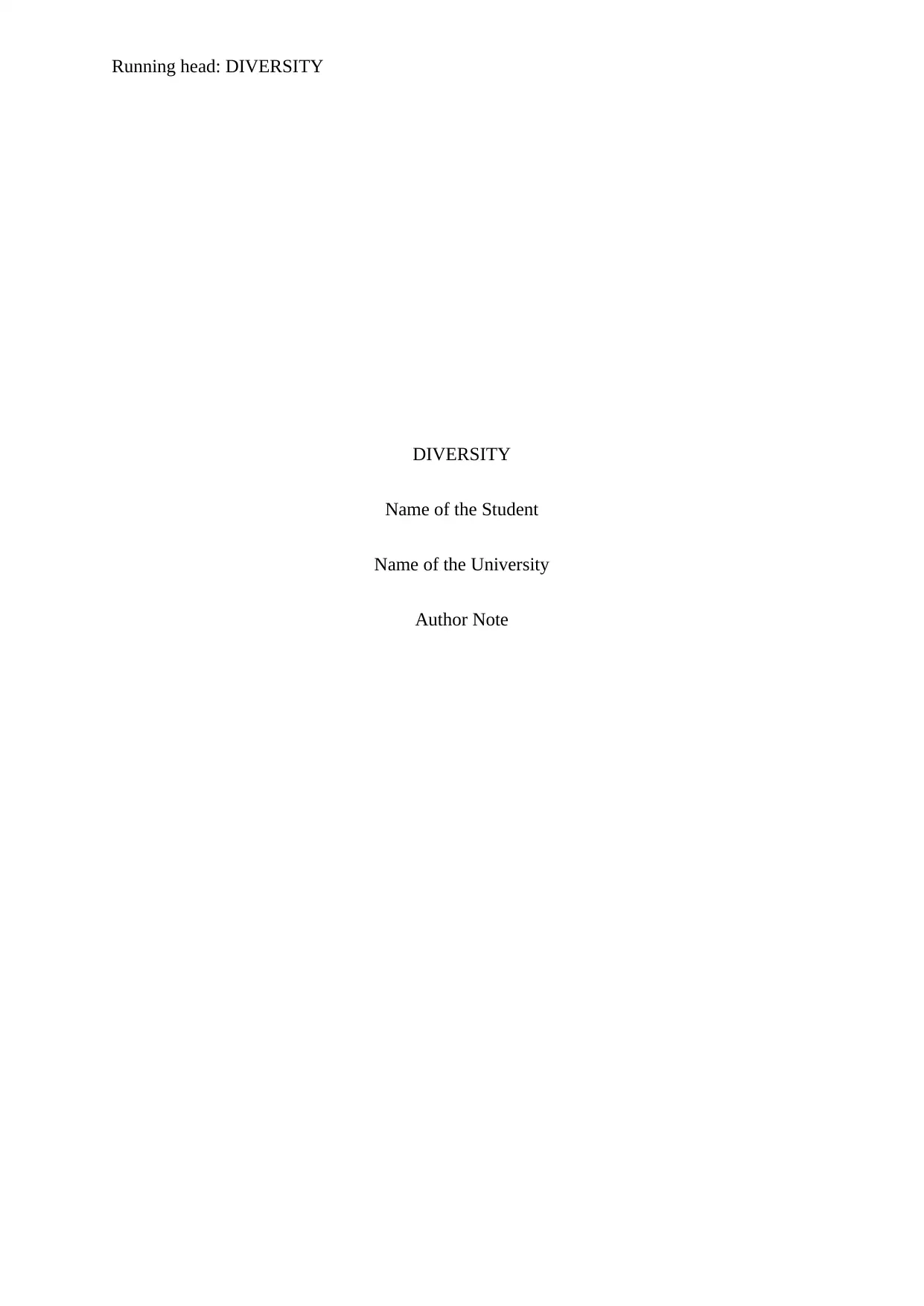
Running head: DIVERSITY
DIVERSITY
Name of the Student
Name of the University
Author Note
DIVERSITY
Name of the Student
Name of the University
Author Note
Paraphrase This Document
Need a fresh take? Get an instant paraphrase of this document with our AI Paraphraser
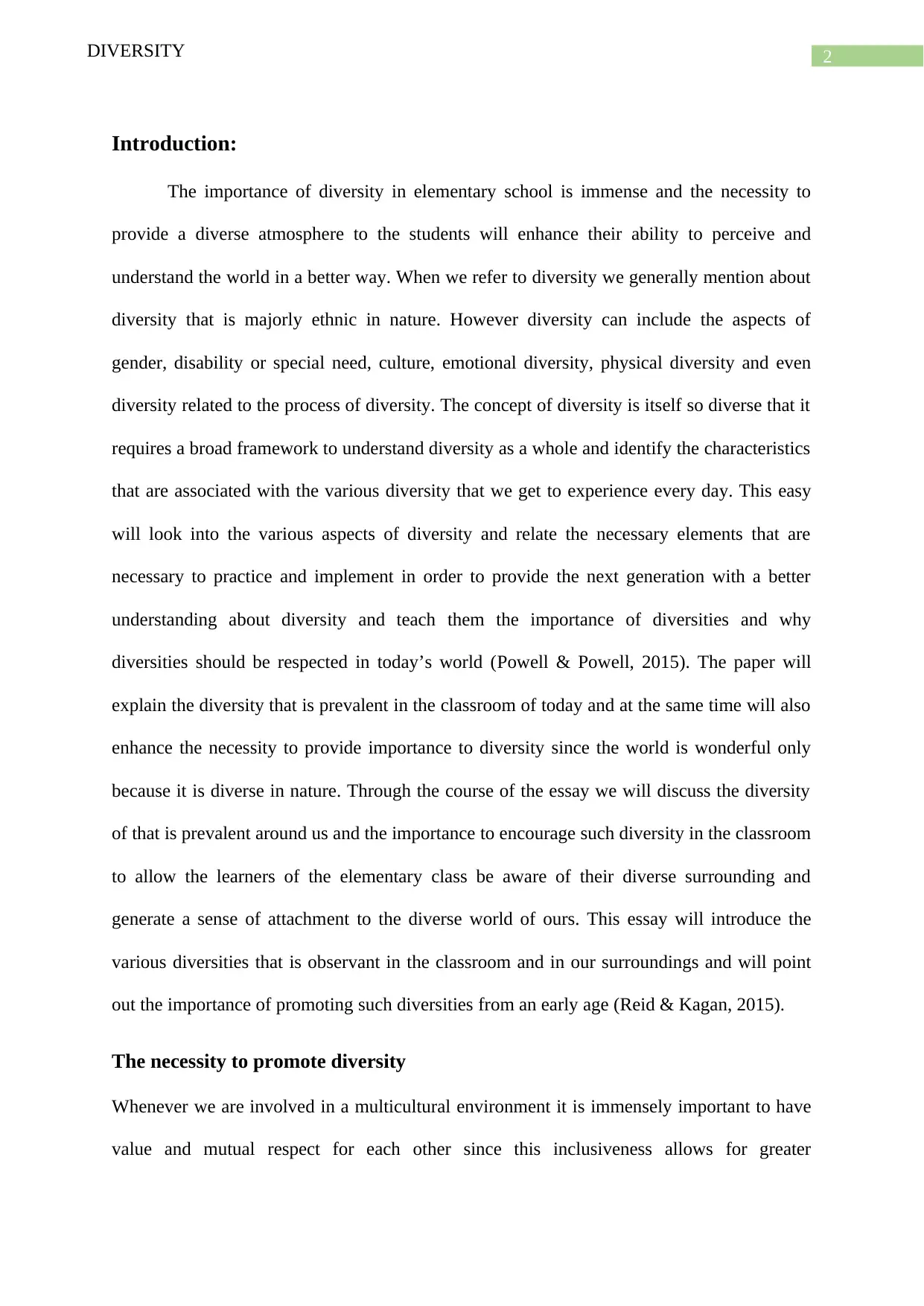
2DIVERSITY
Introduction:
The importance of diversity in elementary school is immense and the necessity to
provide a diverse atmosphere to the students will enhance their ability to perceive and
understand the world in a better way. When we refer to diversity we generally mention about
diversity that is majorly ethnic in nature. However diversity can include the aspects of
gender, disability or special need, culture, emotional diversity, physical diversity and even
diversity related to the process of diversity. The concept of diversity is itself so diverse that it
requires a broad framework to understand diversity as a whole and identify the characteristics
that are associated with the various diversity that we get to experience every day. This easy
will look into the various aspects of diversity and relate the necessary elements that are
necessary to practice and implement in order to provide the next generation with a better
understanding about diversity and teach them the importance of diversities and why
diversities should be respected in today’s world (Powell & Powell, 2015). The paper will
explain the diversity that is prevalent in the classroom of today and at the same time will also
enhance the necessity to provide importance to diversity since the world is wonderful only
because it is diverse in nature. Through the course of the essay we will discuss the diversity
of that is prevalent around us and the importance to encourage such diversity in the classroom
to allow the learners of the elementary class be aware of their diverse surrounding and
generate a sense of attachment to the diverse world of ours. This essay will introduce the
various diversities that is observant in the classroom and in our surroundings and will point
out the importance of promoting such diversities from an early age (Reid & Kagan, 2015).
The necessity to promote diversity
Whenever we are involved in a multicultural environment it is immensely important to have
value and mutual respect for each other since this inclusiveness allows for greater
Introduction:
The importance of diversity in elementary school is immense and the necessity to
provide a diverse atmosphere to the students will enhance their ability to perceive and
understand the world in a better way. When we refer to diversity we generally mention about
diversity that is majorly ethnic in nature. However diversity can include the aspects of
gender, disability or special need, culture, emotional diversity, physical diversity and even
diversity related to the process of diversity. The concept of diversity is itself so diverse that it
requires a broad framework to understand diversity as a whole and identify the characteristics
that are associated with the various diversity that we get to experience every day. This easy
will look into the various aspects of diversity and relate the necessary elements that are
necessary to practice and implement in order to provide the next generation with a better
understanding about diversity and teach them the importance of diversities and why
diversities should be respected in today’s world (Powell & Powell, 2015). The paper will
explain the diversity that is prevalent in the classroom of today and at the same time will also
enhance the necessity to provide importance to diversity since the world is wonderful only
because it is diverse in nature. Through the course of the essay we will discuss the diversity
of that is prevalent around us and the importance to encourage such diversity in the classroom
to allow the learners of the elementary class be aware of their diverse surrounding and
generate a sense of attachment to the diverse world of ours. This essay will introduce the
various diversities that is observant in the classroom and in our surroundings and will point
out the importance of promoting such diversities from an early age (Reid & Kagan, 2015).
The necessity to promote diversity
Whenever we are involved in a multicultural environment it is immensely important to have
value and mutual respect for each other since this inclusiveness allows for greater
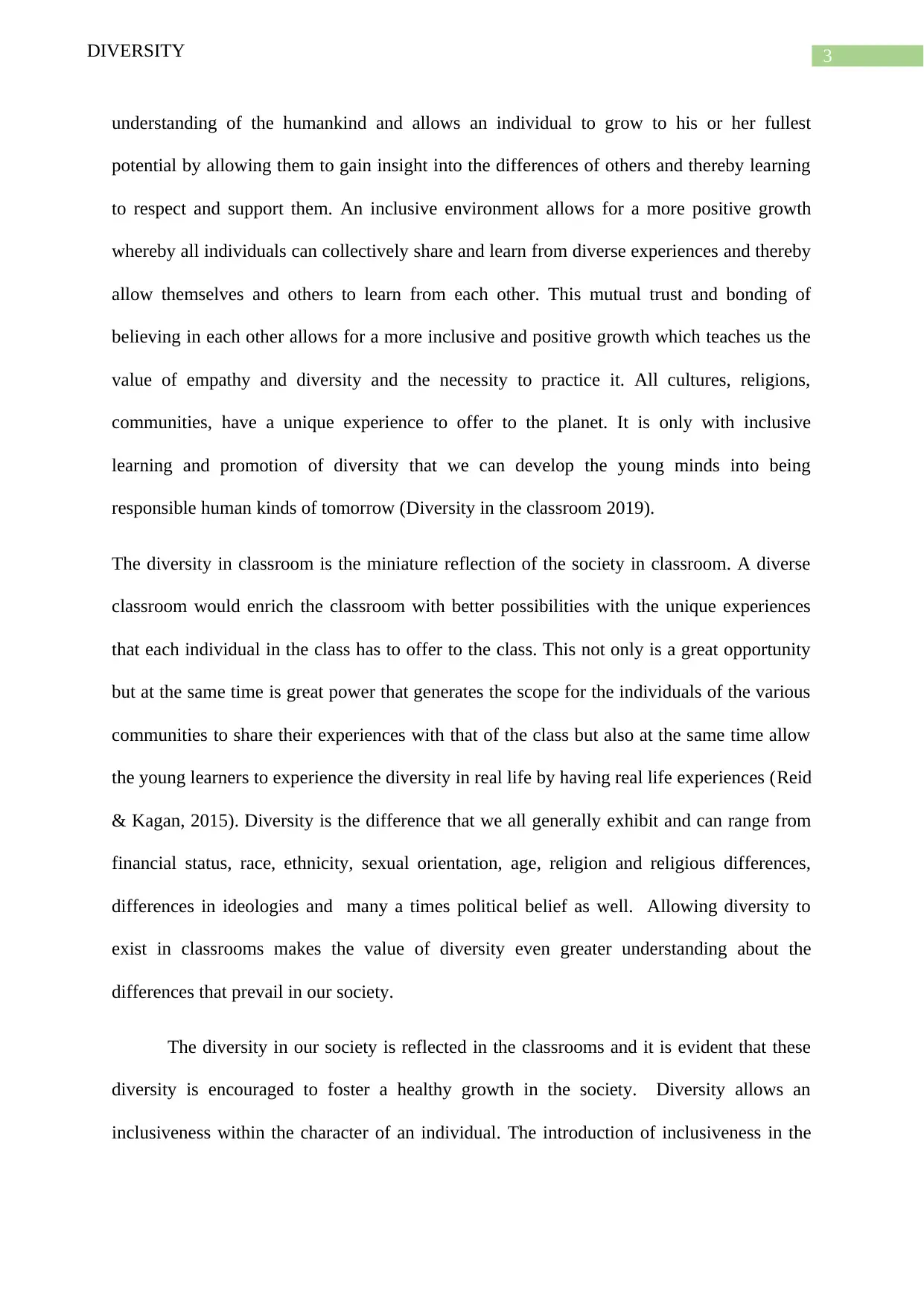
3DIVERSITY
understanding of the humankind and allows an individual to grow to his or her fullest
potential by allowing them to gain insight into the differences of others and thereby learning
to respect and support them. An inclusive environment allows for a more positive growth
whereby all individuals can collectively share and learn from diverse experiences and thereby
allow themselves and others to learn from each other. This mutual trust and bonding of
believing in each other allows for a more inclusive and positive growth which teaches us the
value of empathy and diversity and the necessity to practice it. All cultures, religions,
communities, have a unique experience to offer to the planet. It is only with inclusive
learning and promotion of diversity that we can develop the young minds into being
responsible human kinds of tomorrow (Diversity in the classroom 2019).
The diversity in classroom is the miniature reflection of the society in classroom. A diverse
classroom would enrich the classroom with better possibilities with the unique experiences
that each individual in the class has to offer to the class. This not only is a great opportunity
but at the same time is great power that generates the scope for the individuals of the various
communities to share their experiences with that of the class but also at the same time allow
the young learners to experience the diversity in real life by having real life experiences (Reid
& Kagan, 2015). Diversity is the difference that we all generally exhibit and can range from
financial status, race, ethnicity, sexual orientation, age, religion and religious differences,
differences in ideologies and many a times political belief as well. Allowing diversity to
exist in classrooms makes the value of diversity even greater understanding about the
differences that prevail in our society.
The diversity in our society is reflected in the classrooms and it is evident that these
diversity is encouraged to foster a healthy growth in the society. Diversity allows an
inclusiveness within the character of an individual. The introduction of inclusiveness in the
understanding of the humankind and allows an individual to grow to his or her fullest
potential by allowing them to gain insight into the differences of others and thereby learning
to respect and support them. An inclusive environment allows for a more positive growth
whereby all individuals can collectively share and learn from diverse experiences and thereby
allow themselves and others to learn from each other. This mutual trust and bonding of
believing in each other allows for a more inclusive and positive growth which teaches us the
value of empathy and diversity and the necessity to practice it. All cultures, religions,
communities, have a unique experience to offer to the planet. It is only with inclusive
learning and promotion of diversity that we can develop the young minds into being
responsible human kinds of tomorrow (Diversity in the classroom 2019).
The diversity in classroom is the miniature reflection of the society in classroom. A diverse
classroom would enrich the classroom with better possibilities with the unique experiences
that each individual in the class has to offer to the class. This not only is a great opportunity
but at the same time is great power that generates the scope for the individuals of the various
communities to share their experiences with that of the class but also at the same time allow
the young learners to experience the diversity in real life by having real life experiences (Reid
& Kagan, 2015). Diversity is the difference that we all generally exhibit and can range from
financial status, race, ethnicity, sexual orientation, age, religion and religious differences,
differences in ideologies and many a times political belief as well. Allowing diversity to
exist in classrooms makes the value of diversity even greater understanding about the
differences that prevail in our society.
The diversity in our society is reflected in the classrooms and it is evident that these
diversity is encouraged to foster a healthy growth in the society. Diversity allows an
inclusiveness within the character of an individual. The introduction of inclusiveness in the
⊘ This is a preview!⊘
Do you want full access?
Subscribe today to unlock all pages.

Trusted by 1+ million students worldwide
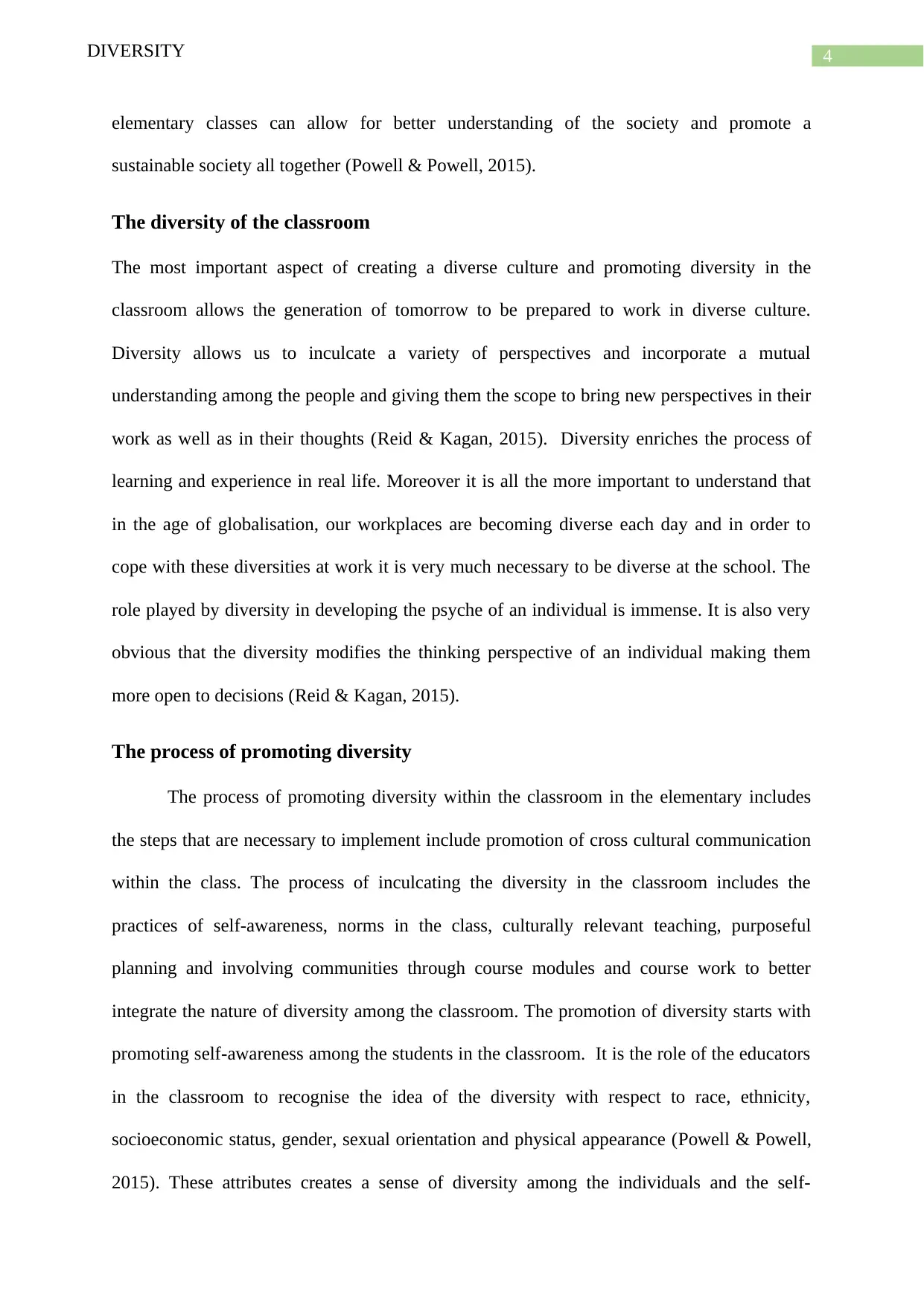
4DIVERSITY
elementary classes can allow for better understanding of the society and promote a
sustainable society all together (Powell & Powell, 2015).
The diversity of the classroom
The most important aspect of creating a diverse culture and promoting diversity in the
classroom allows the generation of tomorrow to be prepared to work in diverse culture.
Diversity allows us to inculcate a variety of perspectives and incorporate a mutual
understanding among the people and giving them the scope to bring new perspectives in their
work as well as in their thoughts (Reid & Kagan, 2015). Diversity enriches the process of
learning and experience in real life. Moreover it is all the more important to understand that
in the age of globalisation, our workplaces are becoming diverse each day and in order to
cope with these diversities at work it is very much necessary to be diverse at the school. The
role played by diversity in developing the psyche of an individual is immense. It is also very
obvious that the diversity modifies the thinking perspective of an individual making them
more open to decisions (Reid & Kagan, 2015).
The process of promoting diversity
The process of promoting diversity within the classroom in the elementary includes
the steps that are necessary to implement include promotion of cross cultural communication
within the class. The process of inculcating the diversity in the classroom includes the
practices of self-awareness, norms in the class, culturally relevant teaching, purposeful
planning and involving communities through course modules and course work to better
integrate the nature of diversity among the classroom. The promotion of diversity starts with
promoting self-awareness among the students in the classroom. It is the role of the educators
in the classroom to recognise the idea of the diversity with respect to race, ethnicity,
socioeconomic status, gender, sexual orientation and physical appearance (Powell & Powell,
2015). These attributes creates a sense of diversity among the individuals and the self-
elementary classes can allow for better understanding of the society and promote a
sustainable society all together (Powell & Powell, 2015).
The diversity of the classroom
The most important aspect of creating a diverse culture and promoting diversity in the
classroom allows the generation of tomorrow to be prepared to work in diverse culture.
Diversity allows us to inculcate a variety of perspectives and incorporate a mutual
understanding among the people and giving them the scope to bring new perspectives in their
work as well as in their thoughts (Reid & Kagan, 2015). Diversity enriches the process of
learning and experience in real life. Moreover it is all the more important to understand that
in the age of globalisation, our workplaces are becoming diverse each day and in order to
cope with these diversities at work it is very much necessary to be diverse at the school. The
role played by diversity in developing the psyche of an individual is immense. It is also very
obvious that the diversity modifies the thinking perspective of an individual making them
more open to decisions (Reid & Kagan, 2015).
The process of promoting diversity
The process of promoting diversity within the classroom in the elementary includes
the steps that are necessary to implement include promotion of cross cultural communication
within the class. The process of inculcating the diversity in the classroom includes the
practices of self-awareness, norms in the class, culturally relevant teaching, purposeful
planning and involving communities through course modules and course work to better
integrate the nature of diversity among the classroom. The promotion of diversity starts with
promoting self-awareness among the students in the classroom. It is the role of the educators
in the classroom to recognise the idea of the diversity with respect to race, ethnicity,
socioeconomic status, gender, sexual orientation and physical appearance (Powell & Powell,
2015). These attributes creates a sense of diversity among the individuals and the self-
Paraphrase This Document
Need a fresh take? Get an instant paraphrase of this document with our AI Paraphraser
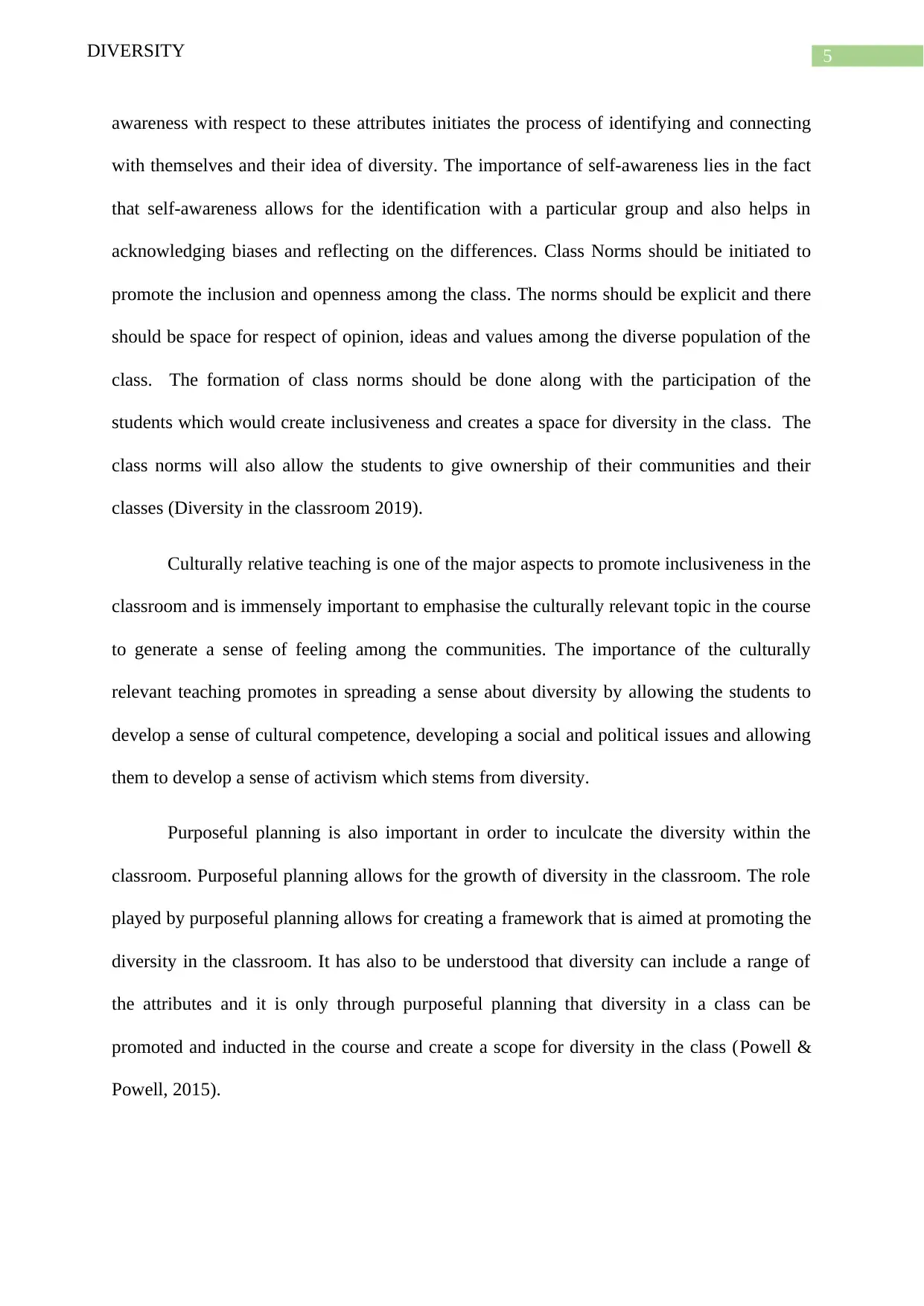
5DIVERSITY
awareness with respect to these attributes initiates the process of identifying and connecting
with themselves and their idea of diversity. The importance of self-awareness lies in the fact
that self-awareness allows for the identification with a particular group and also helps in
acknowledging biases and reflecting on the differences. Class Norms should be initiated to
promote the inclusion and openness among the class. The norms should be explicit and there
should be space for respect of opinion, ideas and values among the diverse population of the
class. The formation of class norms should be done along with the participation of the
students which would create inclusiveness and creates a space for diversity in the class. The
class norms will also allow the students to give ownership of their communities and their
classes (Diversity in the classroom 2019).
Culturally relative teaching is one of the major aspects to promote inclusiveness in the
classroom and is immensely important to emphasise the culturally relevant topic in the course
to generate a sense of feeling among the communities. The importance of the culturally
relevant teaching promotes in spreading a sense about diversity by allowing the students to
develop a sense of cultural competence, developing a social and political issues and allowing
them to develop a sense of activism which stems from diversity.
Purposeful planning is also important in order to inculcate the diversity within the
classroom. Purposeful planning allows for the growth of diversity in the classroom. The role
played by purposeful planning allows for creating a framework that is aimed at promoting the
diversity in the classroom. It has also to be understood that diversity can include a range of
the attributes and it is only through purposeful planning that diversity in a class can be
promoted and inducted in the course and create a scope for diversity in the class (Powell &
Powell, 2015).
awareness with respect to these attributes initiates the process of identifying and connecting
with themselves and their idea of diversity. The importance of self-awareness lies in the fact
that self-awareness allows for the identification with a particular group and also helps in
acknowledging biases and reflecting on the differences. Class Norms should be initiated to
promote the inclusion and openness among the class. The norms should be explicit and there
should be space for respect of opinion, ideas and values among the diverse population of the
class. The formation of class norms should be done along with the participation of the
students which would create inclusiveness and creates a space for diversity in the class. The
class norms will also allow the students to give ownership of their communities and their
classes (Diversity in the classroom 2019).
Culturally relative teaching is one of the major aspects to promote inclusiveness in the
classroom and is immensely important to emphasise the culturally relevant topic in the course
to generate a sense of feeling among the communities. The importance of the culturally
relevant teaching promotes in spreading a sense about diversity by allowing the students to
develop a sense of cultural competence, developing a social and political issues and allowing
them to develop a sense of activism which stems from diversity.
Purposeful planning is also important in order to inculcate the diversity within the
classroom. Purposeful planning allows for the growth of diversity in the classroom. The role
played by purposeful planning allows for creating a framework that is aimed at promoting the
diversity in the classroom. It has also to be understood that diversity can include a range of
the attributes and it is only through purposeful planning that diversity in a class can be
promoted and inducted in the course and create a scope for diversity in the class (Powell &
Powell, 2015).
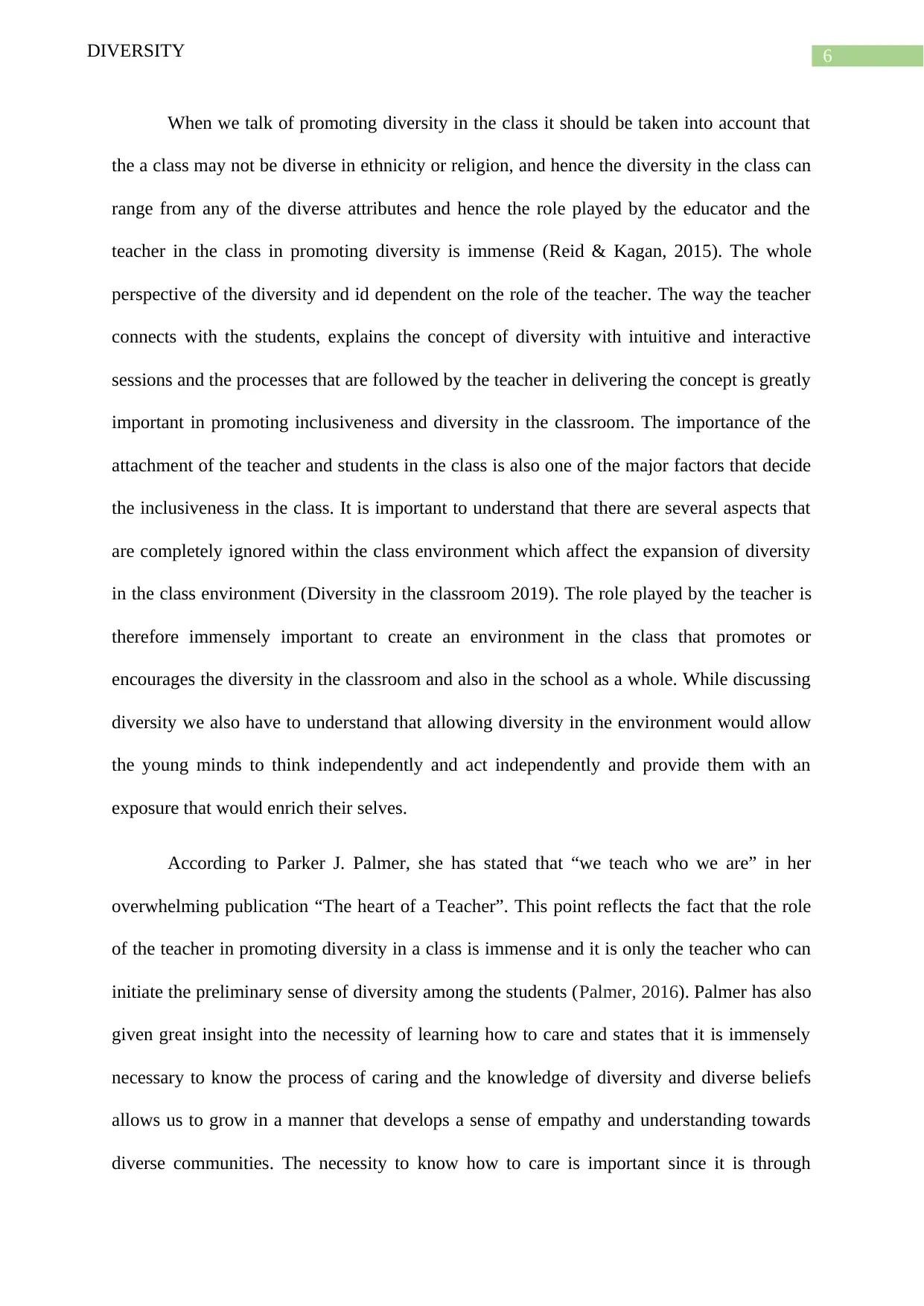
6DIVERSITY
When we talk of promoting diversity in the class it should be taken into account that
the a class may not be diverse in ethnicity or religion, and hence the diversity in the class can
range from any of the diverse attributes and hence the role played by the educator and the
teacher in the class in promoting diversity is immense (Reid & Kagan, 2015). The whole
perspective of the diversity and id dependent on the role of the teacher. The way the teacher
connects with the students, explains the concept of diversity with intuitive and interactive
sessions and the processes that are followed by the teacher in delivering the concept is greatly
important in promoting inclusiveness and diversity in the classroom. The importance of the
attachment of the teacher and students in the class is also one of the major factors that decide
the inclusiveness in the class. It is important to understand that there are several aspects that
are completely ignored within the class environment which affect the expansion of diversity
in the class environment (Diversity in the classroom 2019). The role played by the teacher is
therefore immensely important to create an environment in the class that promotes or
encourages the diversity in the classroom and also in the school as a whole. While discussing
diversity we also have to understand that allowing diversity in the environment would allow
the young minds to think independently and act independently and provide them with an
exposure that would enrich their selves.
According to Parker J. Palmer, she has stated that “we teach who we are” in her
overwhelming publication “The heart of a Teacher”. This point reflects the fact that the role
of the teacher in promoting diversity in a class is immense and it is only the teacher who can
initiate the preliminary sense of diversity among the students (Palmer, 2016). Palmer has also
given great insight into the necessity of learning how to care and states that it is immensely
necessary to know the process of caring and the knowledge of diversity and diverse beliefs
allows us to grow in a manner that develops a sense of empathy and understanding towards
diverse communities. The necessity to know how to care is important since it is through
When we talk of promoting diversity in the class it should be taken into account that
the a class may not be diverse in ethnicity or religion, and hence the diversity in the class can
range from any of the diverse attributes and hence the role played by the educator and the
teacher in the class in promoting diversity is immense (Reid & Kagan, 2015). The whole
perspective of the diversity and id dependent on the role of the teacher. The way the teacher
connects with the students, explains the concept of diversity with intuitive and interactive
sessions and the processes that are followed by the teacher in delivering the concept is greatly
important in promoting inclusiveness and diversity in the classroom. The importance of the
attachment of the teacher and students in the class is also one of the major factors that decide
the inclusiveness in the class. It is important to understand that there are several aspects that
are completely ignored within the class environment which affect the expansion of diversity
in the class environment (Diversity in the classroom 2019). The role played by the teacher is
therefore immensely important to create an environment in the class that promotes or
encourages the diversity in the classroom and also in the school as a whole. While discussing
diversity we also have to understand that allowing diversity in the environment would allow
the young minds to think independently and act independently and provide them with an
exposure that would enrich their selves.
According to Parker J. Palmer, she has stated that “we teach who we are” in her
overwhelming publication “The heart of a Teacher”. This point reflects the fact that the role
of the teacher in promoting diversity in a class is immense and it is only the teacher who can
initiate the preliminary sense of diversity among the students (Palmer, 2016). Palmer has also
given great insight into the necessity of learning how to care and states that it is immensely
necessary to know the process of caring and the knowledge of diversity and diverse beliefs
allows us to grow in a manner that develops a sense of empathy and understanding towards
diverse communities. The necessity to know how to care is important since it is through
⊘ This is a preview!⊘
Do you want full access?
Subscribe today to unlock all pages.

Trusted by 1+ million students worldwide
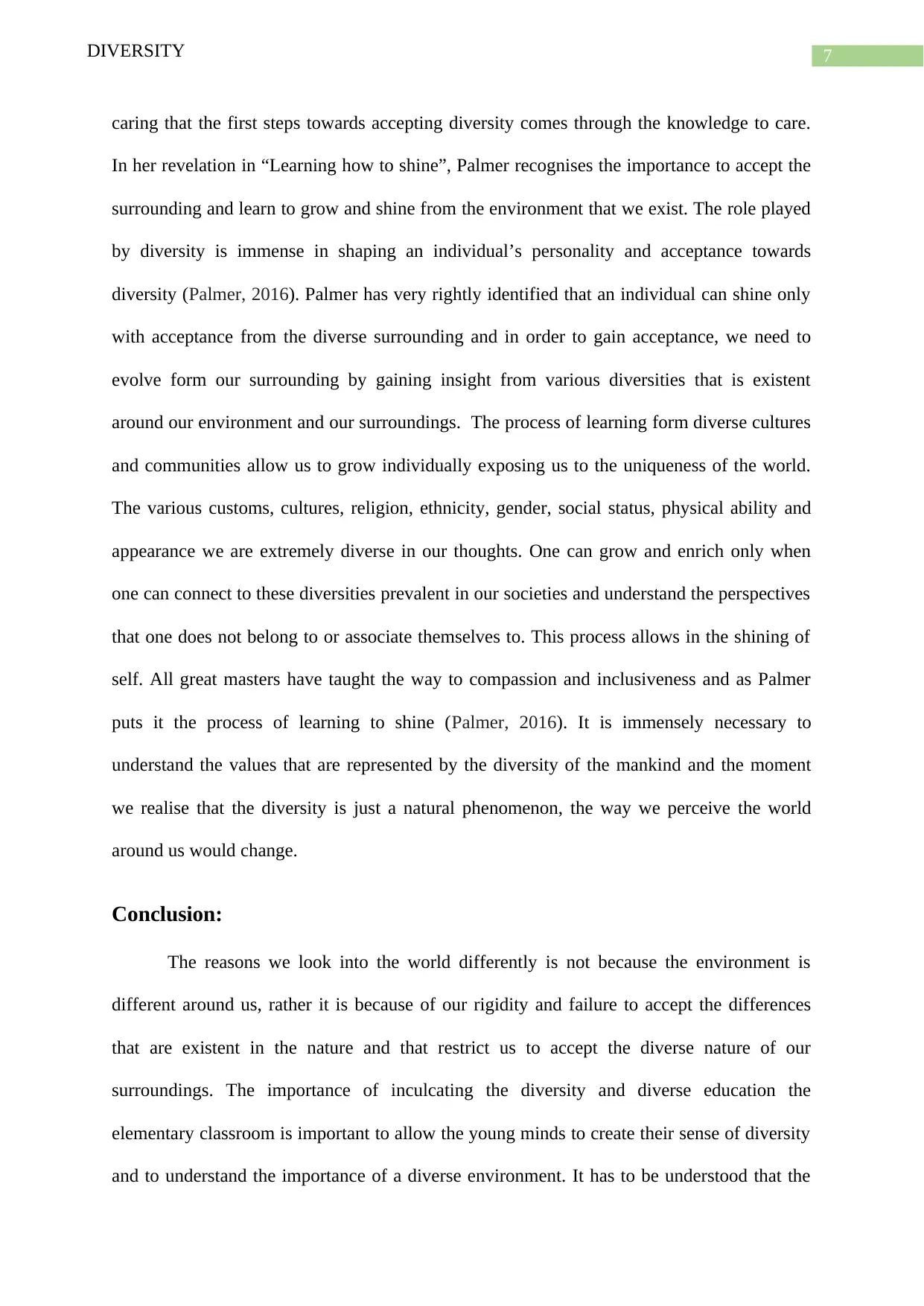
7DIVERSITY
caring that the first steps towards accepting diversity comes through the knowledge to care.
In her revelation in “Learning how to shine”, Palmer recognises the importance to accept the
surrounding and learn to grow and shine from the environment that we exist. The role played
by diversity is immense in shaping an individual’s personality and acceptance towards
diversity (Palmer, 2016). Palmer has very rightly identified that an individual can shine only
with acceptance from the diverse surrounding and in order to gain acceptance, we need to
evolve form our surrounding by gaining insight from various diversities that is existent
around our environment and our surroundings. The process of learning form diverse cultures
and communities allow us to grow individually exposing us to the uniqueness of the world.
The various customs, cultures, religion, ethnicity, gender, social status, physical ability and
appearance we are extremely diverse in our thoughts. One can grow and enrich only when
one can connect to these diversities prevalent in our societies and understand the perspectives
that one does not belong to or associate themselves to. This process allows in the shining of
self. All great masters have taught the way to compassion and inclusiveness and as Palmer
puts it the process of learning to shine (Palmer, 2016). It is immensely necessary to
understand the values that are represented by the diversity of the mankind and the moment
we realise that the diversity is just a natural phenomenon, the way we perceive the world
around us would change.
Conclusion:
The reasons we look into the world differently is not because the environment is
different around us, rather it is because of our rigidity and failure to accept the differences
that are existent in the nature and that restrict us to accept the diverse nature of our
surroundings. The importance of inculcating the diversity and diverse education the
elementary classroom is important to allow the young minds to create their sense of diversity
and to understand the importance of a diverse environment. It has to be understood that the
caring that the first steps towards accepting diversity comes through the knowledge to care.
In her revelation in “Learning how to shine”, Palmer recognises the importance to accept the
surrounding and learn to grow and shine from the environment that we exist. The role played
by diversity is immense in shaping an individual’s personality and acceptance towards
diversity (Palmer, 2016). Palmer has very rightly identified that an individual can shine only
with acceptance from the diverse surrounding and in order to gain acceptance, we need to
evolve form our surrounding by gaining insight from various diversities that is existent
around our environment and our surroundings. The process of learning form diverse cultures
and communities allow us to grow individually exposing us to the uniqueness of the world.
The various customs, cultures, religion, ethnicity, gender, social status, physical ability and
appearance we are extremely diverse in our thoughts. One can grow and enrich only when
one can connect to these diversities prevalent in our societies and understand the perspectives
that one does not belong to or associate themselves to. This process allows in the shining of
self. All great masters have taught the way to compassion and inclusiveness and as Palmer
puts it the process of learning to shine (Palmer, 2016). It is immensely necessary to
understand the values that are represented by the diversity of the mankind and the moment
we realise that the diversity is just a natural phenomenon, the way we perceive the world
around us would change.
Conclusion:
The reasons we look into the world differently is not because the environment is
different around us, rather it is because of our rigidity and failure to accept the differences
that are existent in the nature and that restrict us to accept the diverse nature of our
surroundings. The importance of inculcating the diversity and diverse education the
elementary classroom is important to allow the young minds to create their sense of diversity
and to understand the importance of a diverse environment. It has to be understood that the
Paraphrase This Document
Need a fresh take? Get an instant paraphrase of this document with our AI Paraphraser
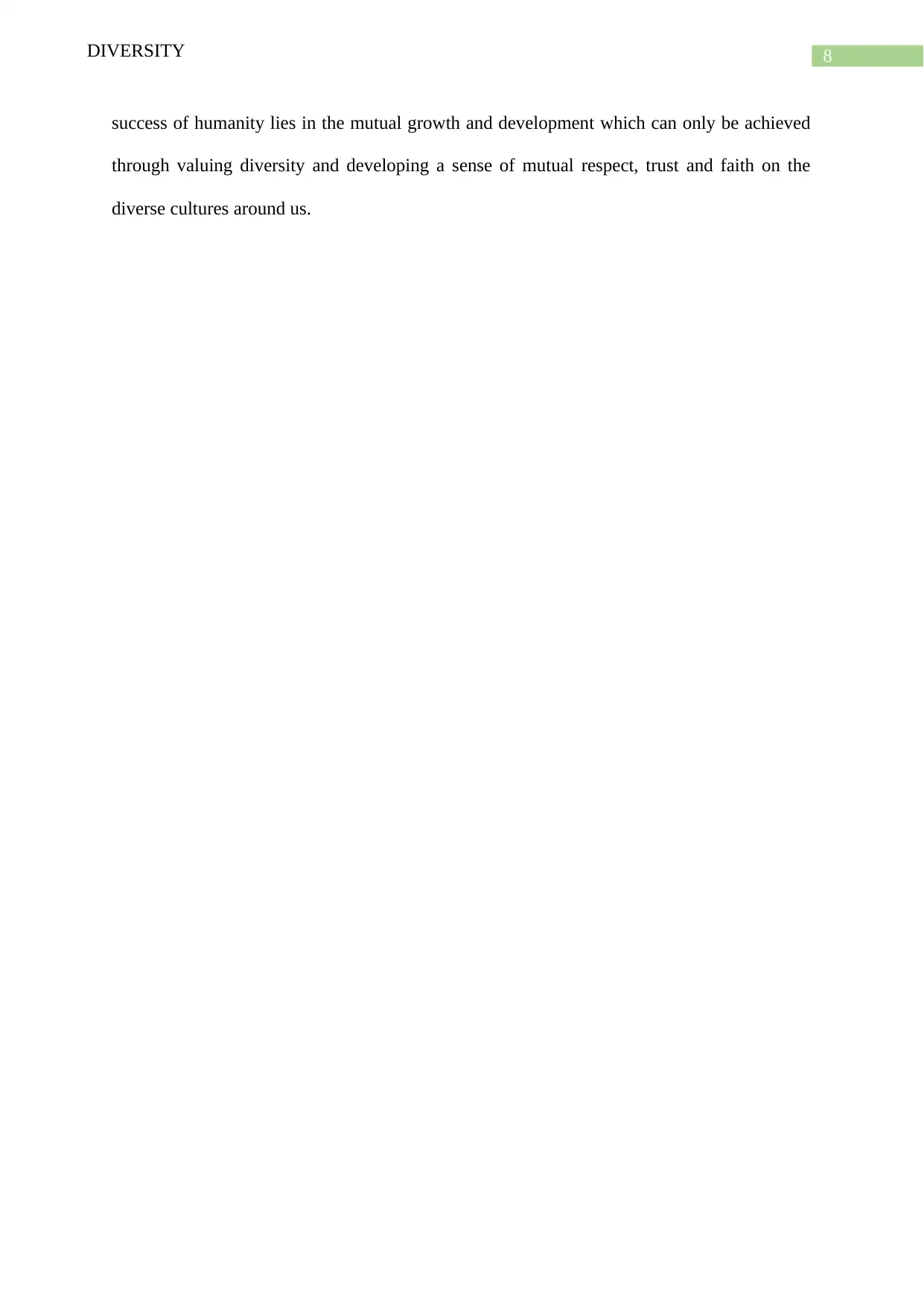
8DIVERSITY
success of humanity lies in the mutual growth and development which can only be achieved
through valuing diversity and developing a sense of mutual respect, trust and faith on the
diverse cultures around us.
success of humanity lies in the mutual growth and development which can only be achieved
through valuing diversity and developing a sense of mutual respect, trust and faith on the
diverse cultures around us.
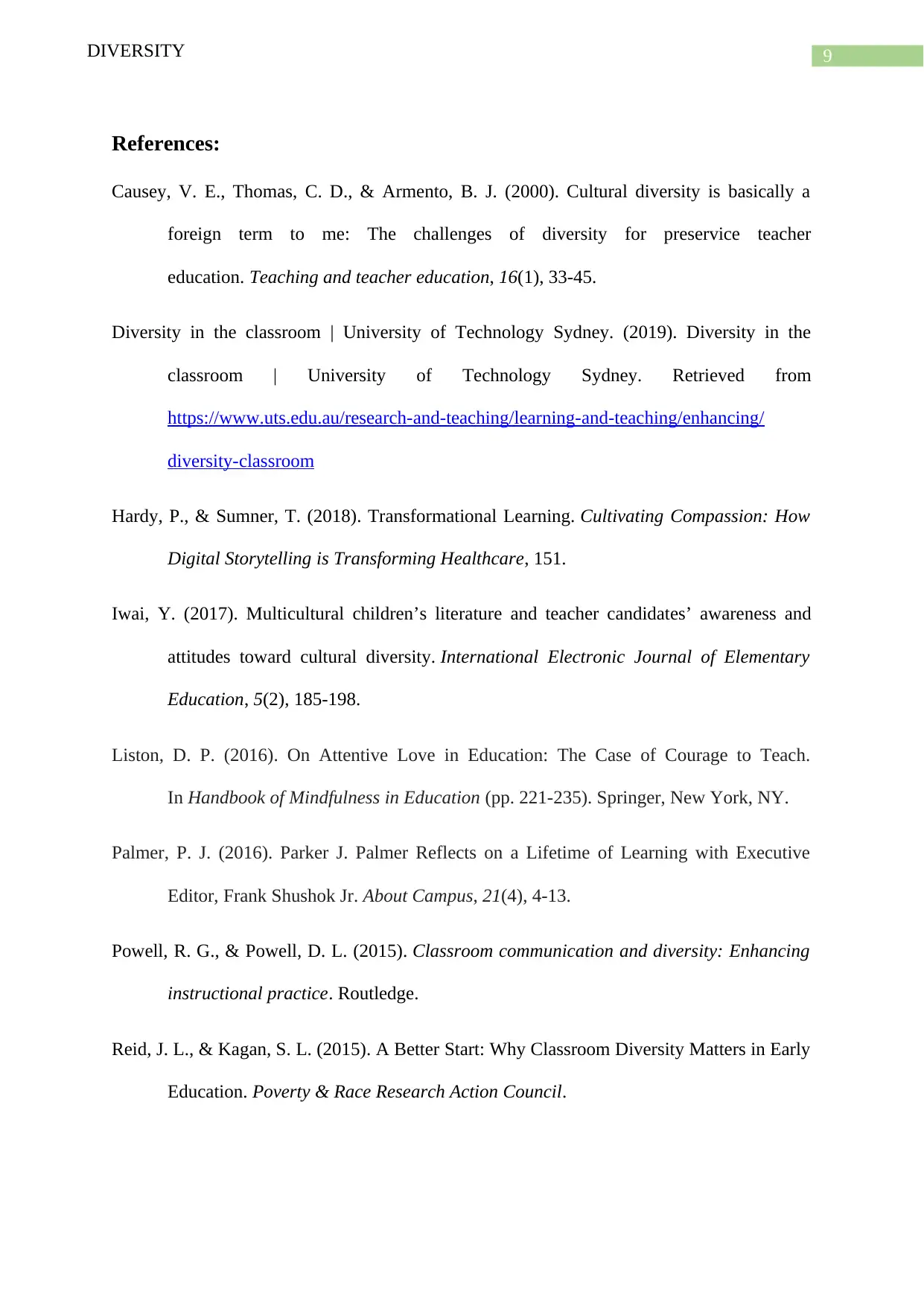
9DIVERSITY
References:
Causey, V. E., Thomas, C. D., & Armento, B. J. (2000). Cultural diversity is basically a
foreign term to me: The challenges of diversity for preservice teacher
education. Teaching and teacher education, 16(1), 33-45.
Diversity in the classroom | University of Technology Sydney. (2019). Diversity in the
classroom | University of Technology Sydney. Retrieved from
https://www.uts.edu.au/research-and-teaching/learning-and-teaching/enhancing/
diversity-classroom
Hardy, P., & Sumner, T. (2018). Transformational Learning. Cultivating Compassion: How
Digital Storytelling is Transforming Healthcare, 151.
Iwai, Y. (2017). Multicultural children’s literature and teacher candidates’ awareness and
attitudes toward cultural diversity. International Electronic Journal of Elementary
Education, 5(2), 185-198.
Liston, D. P. (2016). On Attentive Love in Education: The Case of Courage to Teach.
In Handbook of Mindfulness in Education (pp. 221-235). Springer, New York, NY.
Palmer, P. J. (2016). Parker J. Palmer Reflects on a Lifetime of Learning with Executive
Editor, Frank Shushok Jr. About Campus, 21(4), 4-13.
Powell, R. G., & Powell, D. L. (2015). Classroom communication and diversity: Enhancing
instructional practice. Routledge.
Reid, J. L., & Kagan, S. L. (2015). A Better Start: Why Classroom Diversity Matters in Early
Education. Poverty & Race Research Action Council.
References:
Causey, V. E., Thomas, C. D., & Armento, B. J. (2000). Cultural diversity is basically a
foreign term to me: The challenges of diversity for preservice teacher
education. Teaching and teacher education, 16(1), 33-45.
Diversity in the classroom | University of Technology Sydney. (2019). Diversity in the
classroom | University of Technology Sydney. Retrieved from
https://www.uts.edu.au/research-and-teaching/learning-and-teaching/enhancing/
diversity-classroom
Hardy, P., & Sumner, T. (2018). Transformational Learning. Cultivating Compassion: How
Digital Storytelling is Transforming Healthcare, 151.
Iwai, Y. (2017). Multicultural children’s literature and teacher candidates’ awareness and
attitudes toward cultural diversity. International Electronic Journal of Elementary
Education, 5(2), 185-198.
Liston, D. P. (2016). On Attentive Love in Education: The Case of Courage to Teach.
In Handbook of Mindfulness in Education (pp. 221-235). Springer, New York, NY.
Palmer, P. J. (2016). Parker J. Palmer Reflects on a Lifetime of Learning with Executive
Editor, Frank Shushok Jr. About Campus, 21(4), 4-13.
Powell, R. G., & Powell, D. L. (2015). Classroom communication and diversity: Enhancing
instructional practice. Routledge.
Reid, J. L., & Kagan, S. L. (2015). A Better Start: Why Classroom Diversity Matters in Early
Education. Poverty & Race Research Action Council.
⊘ This is a preview!⊘
Do you want full access?
Subscribe today to unlock all pages.

Trusted by 1+ million students worldwide
1 out of 9
Related Documents
Your All-in-One AI-Powered Toolkit for Academic Success.
+13062052269
info@desklib.com
Available 24*7 on WhatsApp / Email
![[object Object]](/_next/static/media/star-bottom.7253800d.svg)
Unlock your academic potential
Copyright © 2020–2025 A2Z Services. All Rights Reserved. Developed and managed by ZUCOL.





